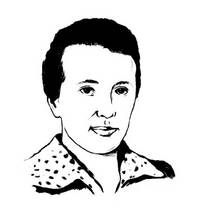


After the National Socialists withdrew her license to teach, it was impossible for Gertrud Kornfeld to continue her university Career . She emigrated to the USA and did research for the photo film manufacturer Eastman Kodak until the end of her life.
Gertrud Kornfeld was born on July 25, 1891 in Prague. As the daughter of a German-speaking Bohemian factory owner family who belonged to the upper Jewish bourgeoisie, she received an excellent school education. With the Austrian Abitur she finally achieved the prerequisites for studying.
From 1910 to 1915 Kornfeld studied chemistry, physical chemistry and physics at the German-speaking Karl Ferdinand University in Prague. From 1914 on she did research there in the working group of her mentor Viktor Rothmund (1870-1927), who mainly dealt with the electrochemical reduction and the so-called passivity of metals. Kornfeld received his doctorate in 1915 with a thesis on "hydrates in solution" and worked as an assistant at the chemical institute at Prague University until 1918 or 1919 (see note below). With the beginning of the First World War, women scientists at several German universities were finally allowed to fill an academic position. During this time, Kornfeld deepened her knowledge of chemical reaction kinetics, a research area that was emerging at the time.
Since Kornfeld belonged to the German-speaking population of Prague, she left the city in 1919 with the establishment of Czechoslovakia. As a former assistant to Rothmund, she immediately received a research assistant position with Max Bodenstein (1871-1942) at the Technical University of Hanover, where she stayed until 1923 or 1925 (see note below). Bodenstein is one of the founders of chemical reaction kinetics. Above all, he researched light-induced chain reactions such as the chlorine detonating gas reaction, in which hydrogen chloride is formed from the elements. In addition, he made other important contributions to photochemistry. Both areas - photochemistry and reaction kinetics - now also formed Kornfeld's main research areas.
Bodenstein received a call to Berlin in 1923 as the successor to Nobel Prize winner Walther Nernst (1864-1941) and with him Kornfeld also moved to the physical-chemical institute of the university there. In 1928 she qualified as a professor in Berlin for chemistry. She continued to be an assistant at Bodenstein, supervised several doctoral theses and carried out her teaching duties with great enthusiasm. Kornfeld was also successful in research: around 1929 she developed the membrane manometer, which measures pressures of up to 16 millibars. It is based on the fact that the gas pressure bends a thin sheet of metal and thus moves a pointer.
In addition to her successes, Kornfeld had to record many disappointments and frustrations that ultimately made a university career impossible. After the National Socialists withdrew her license to teach in autumn 1933, the now 42-year-old chemist spontaneously traveled to England on a scholarship. She did research at the University of Nottingham and Imperial College in London, but without getting a permanent job. The relatively high position in science that she once held in Berlin was never achieved in Great Britain. Supported by another scholarship, she worked at the University of Vienna until 1936. From there she emigrated to the USA in 1937 on a visitor visa.
In the United States, too, Kornfeld was unable to continue her university career. She joined Eastman Kodak in Rochester, New York, as a research chemist. She worked for the manufacturer of films and other photographic equipment until the end of her life. Kornfeld received American citizenship in 1943. She was never married.
Kornfeld got to know both the university and the industrial facets of her profession and is without question one of the outstanding chemists of the first half of the 20th century. Her early research was trend-setting for photochemistry, but it was not granted to her to build on these successes in the later phases of life. Gertrud Kornfeld died in the summer of 1955 a few weeks before her 64th birthday in Rochester (USA).
Note: different information in different sources
a notice
The texts published in this series do not claim to be scientific publications. Authors and other people involved are not experts in the history of science. The purpose of the series is to introduce the mostly unknown women chemists and to remind you of the well-known women chemists. We encourage readers who want to know more to study academic Literature on the women featured. In some cases there are detailed chemical-historical works.
authors
Prof. Dr. Eberhard Ehlers
Prof. Dr. Heribert Offermanns
Editorial processing
Dr Uta Neubauer
project management
Dr Karin J. Schmitz (GDCh public relations)
The authors are responsible for the content of the biographies.
The content presented on these pages has been carefully compiled. However, the authors, Editorial staff and publishers assume no responsibility or liability for the completeness and correctness of the content or for typographical errors.
Illustration: Humboldt University of Berlin / Institute for computer science
Back to overview
Biographies of women chemists
back to publications
This page has been machine translated. If you have any feedback or comments please feel free to contact us. 
last modified: 06.08.2021 09:29 H from K.J.Schmitz